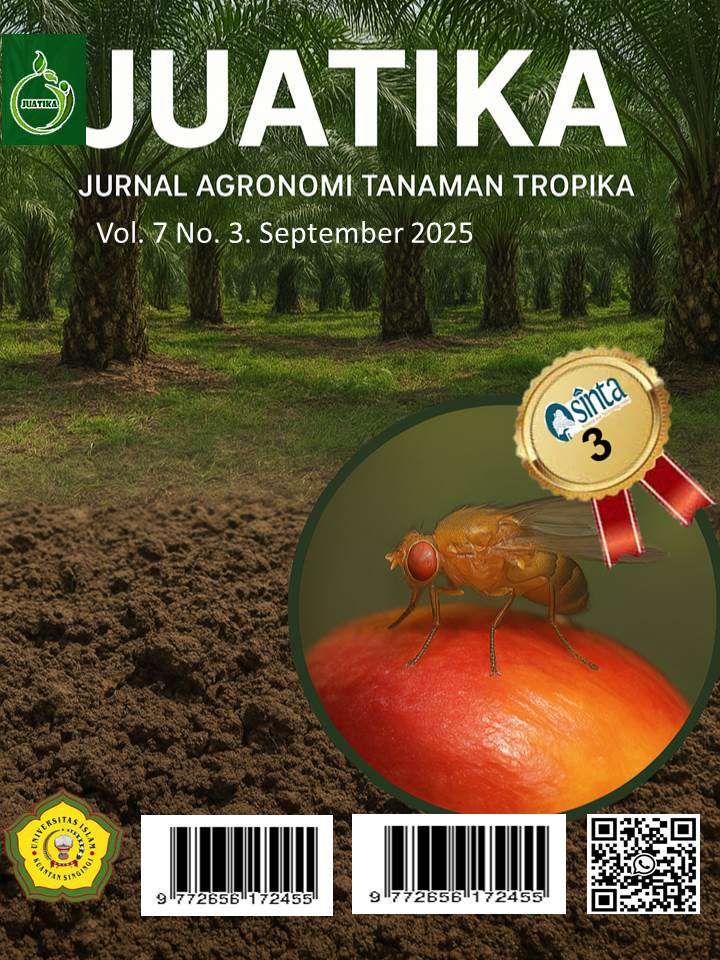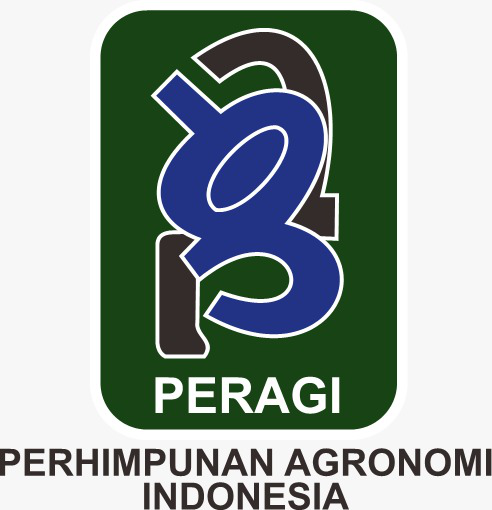The Seed Weight Patterns During Imbibition and Germination Morpho-physiology of Four Maize (Zea mays L.) Seed Varieties
Imbibition Pattern and Morpho-physiological of Maize (Zea mays L.) Seed Germination
Abstract
Suboptimal environmental conditions cause low imbibition rate in maize plants, thus disrupting enzyme activation and food availability for the sprouts, and inhibiting the germination process. This study aims to provide a better understanding of the imbibition pattern and physiological characteristics of germination, hopefully obtaining useful information in the development of seed processing techniques and more efficient agricultural technology. The maize seeds used in this study were the seeds of four maize varieties. The imbibition pattern was obtained by weighing the seeds from 0 to 120 hours with a 6-hour time interval. The results showed that the four varieties showed a typical three-phase imbibition pattern with almost the same time. Overall, the highest seed growth and germination was found in Jantan F1 and Paramita, which have great potential for use in seed propagation, while Baruna variety showed low seed quality and needs further evaluation for improvement.
Downloads
References
Anwar, C. P., & Prapto, Y. (2019). Invigorasi osmoconditioning dengan kalsium klorida untuk perbaikan mutu fisiologis benih padi hitam lokal (Oryza sativa L.). Vegetalika, 8(3), 166–176. https://journal.ugm.ac.id/jbp/article/view/42806
Asih, R. P. (2021). Invigorasi mutu fisiologis benih terung ungu (Solanum melongena L.) kadaluarsa dengan beberapa teknik osmoconditioning. Agritrop: Jurnal Ilmu-Ilmu Pertanian, 18(2), 162–170.
Baskin, C., Thompson, K., & Baskin, J. M. (2006). Mistakes in germination ecology and how to avoid them. Seed Science Research, 16(3), 165–168. https://doi.org/10.1079/SSR2006247
David, A., Araújo, E., Araújo, R., Resende, M., Diaz, D., & Nobre, D. (2013). Physiological quality of castor bean seeds originating from different racemes in the plant. Journal of Seed Science, 35(2), 248–254. https://doi.org/10.1590/s2317-15372013000200016
Han, C., & Yang, P. (2015). Studies on the molecular mechanisms of seed germination. Proteomics, 15(10), 1671–1679. https://doi.org/10.1002/PMIC.201400375
Hartawan, R. (2016). Skarifikasi dan KNO₃ mematahkan dormansi serta meningkatkan viabilitas dan vigor benih aren (Arenga pinnata Merr.). Jurnal Media Pertanian, 1(1), 1–10. https://doi.org/10.33087/jagro.v1i1.10
Jiang, Z., Xu, G., Jing, Y., Tang, W., & Lin, R. (2016). Phytochrome B and REVEILLE1/2-mediated signalling controls seed dormancy and germination in Arabidopsis. Nature Communications, 7(1), 1–10. https://doi.org/10.1038/ncomms12377
Leite, L., Stefanello, R., & Essi, L. (2022). Seed germination of Hesperozygis ringens (Benth.) Epling, an endemic and threatened species. Acta Scientiarum Biological Sciences, 44(1), e58431. https://doi.org/10.4025/actascibiolsci.v44i1.58431
Rachma, Y., Indrati, R., & Supriyadi. (2022). Karakteristik perkecambahan biji lamtoro pada perlakuan skarifikasi serta perubahan nilai gizi setelah perkecambahan. Buletin Anatomi dan Fisiologi, 7(1), 11–19. https://doi.org/10.14710/baf.7.1.2022.11-19
Romero-Luna, H., & Dávila-Ortiz, G. (2019). Enzymes role during seed germination. In R. Mora-Escobedo & C. Martinez (Eds.), Enzymes Role During Seed Germination, Types, Process and Effects. Nova Science Publishers, Inc.
Rosyad, A., Widura Ritonga, A., Mulyana, E., Suwarno, P. M., & Anugrah, M. (2025). Improving seed quality of four genotypes of sweet corn (Zea mays saccharata) based on harvest time and initial water content. Jurnal Agronomi Tanaman Tropika (JUATIKA), 7(2), 516–523. https://doi.org/10.36378/juatika.v7i2.4335
Rosyadita, H., Zamzami, A., & Diaguna, R. (2023). Pemilahan benih kedelai (Glycine max (L.) Merr.) serta hubungan ukuran benih dengan mutu benih. Jurnal Agrosains dan Teknologi, 8(1), 1–10. https://doi.org/10.24853/jat.8.1.1-10
Ruliyansyah, A. (2011). Peningkatan performansi benih kacangan dengan perlakuan invigorasi. Jurnal Perkebunan dan Lahan Tropika, 1(1), 13–18. https://doi.org/10.26418/plt.v1i1.26
Sepyanti, A., Mustamu, N., & Dalimuthe, B. (2025). Optimizing bokashi fertilizer dosage on the growth of corn plants (Zea mays L.) local varieties of North Sumatra that have been irradiated with gamma rays. Jurnal Agronomi Tanaman Tropika (JUATIKA), 7(1), 326–330. https://doi.org/10.36378/juatika.v7i1.4230
Sinaga, H., Hanfiah, D., & Hanum, H. (2025). Utilizing eco-enzyme for dormancy breaking and germination in certified rice seed testing. Jurnal Agronomi Tanaman Tropika (JUATIKA), 7(2), 531–540. https://doi.org/10.36378/juatika.v7i2.4402
Tadidik, U., Kandowangko, N., Febriyanti, Retnowati, Y., & Ahmad, A. (2025). Studi kekerabatan morfologi jagung (Zea mays L.) varietas lokal di Gorontalo. Agrium: Jurnal Ilmu Pertanian, 28(1), 34–46. https://doi.org/10.30596/agrium.v28i1.23146
Yaghoubian, I., Msimbira, L., & Smith, D. (2022). Cell-free supernatant of Bacillus strains can improve seed vigor index of corn (Zea mays L.) under salinity stress. Frontiers in Sustainable Food Systems, 6(1), 1–11. https://doi.org/10.3389/fsufs.2022.857643
Yu, Y., Guo, G., Lv, D., Hu, Y., Li, J., Li, X., & Yan, Y. (2014). Transcriptome analysis during seed germination of elite Chinese bread wheat cultivar Jimai 20. BMC Plant Biology, 14(1). https://doi.org/10.1186/1471-2229-14-20
Yuanasari, B., Kendarini, N., & Saptadi, D. (2015). Peningkatan viabilitas benih kedelai hitam (Glycine max L. Merr.) melalui invigorasi osmoconditioning. Jurnal Produksi Tanaman, 3(6), 518–527. https://doi.org/10.21176/protan.v3i6.230
Yue, G., Yang, R., Lei, D., Du, Y., Li, Y., & Feng, F. (2024). Physiological, biochemical, and ultrastructural changes in naturally aged sweet corn seeds. Agriculture, 14(7), 1–14. https://doi.org/10.3390/agriculture14071039
Zakia, A., Ulum, M., Iriany, A., & Zainudin, A. (2021). Modifikasi teknik invigorasi untuk meningkatkan viabilitas dan vigor benih jagung manis (Zea mays saccharata L.). Journal of Applied Agricultural Science, 5(1), 50–60. https://doi.org/10.25047/agriprima.v5i1.383
Copyright (c) 2025 Punjung Medaraji Suwarno, Evayusvita Rustam, Abdul Qadir, Suwarto, Astryani Rosyad

This work is licensed under a Creative Commons Attribution 4.0 International License.
Authors who publish with Jurnal Agronomi Tanaman Tropika (JUATIKA) agree to the following terms:
Authors retain copyright and grant the Jurnal Agronomi Tanaman Tropika (JUATIKA) right of first publication with the work simultaneously licensed under a Creative Commons Attribution License (CC BY 4.0) that allows others to share (copy and redistribute the material in any medium or format) and adapt (remix, transform, and build upon the material for any purpose, even commercially) with an acknowledgment of the work's authorship and initial publication in Jurnal Agronomi Tanaman Tropika (JUATIKA).
Authors are able to enter into separate, additional contractual arrangements for the non-exclusive distribution of the journal's published version of the work (e.g., post it to an institutional repository or publish it in a book), with an acknowledgment of its initial publication in Jurnal Agronomi Tanaman Tropika (JUATIKA). Authors are permitted and encouraged to post their work online (e.g., in institutional repositories or on their website) prior to and during the submission process, as it can lead to productive exchanges, as well as earlier and greater citation of published work.







 More Information
More Information



